engine CADILLAC DEVILLE 1996 7.G Owners Manual
[x] Cancel search | Manufacturer: CADILLAC, Model Year: 1996, Model line: DEVILLE, Model: CADILLAC DEVILLE 1996 7.GPages: 354, PDF Size: 20.32 MB
Page 241 of 354
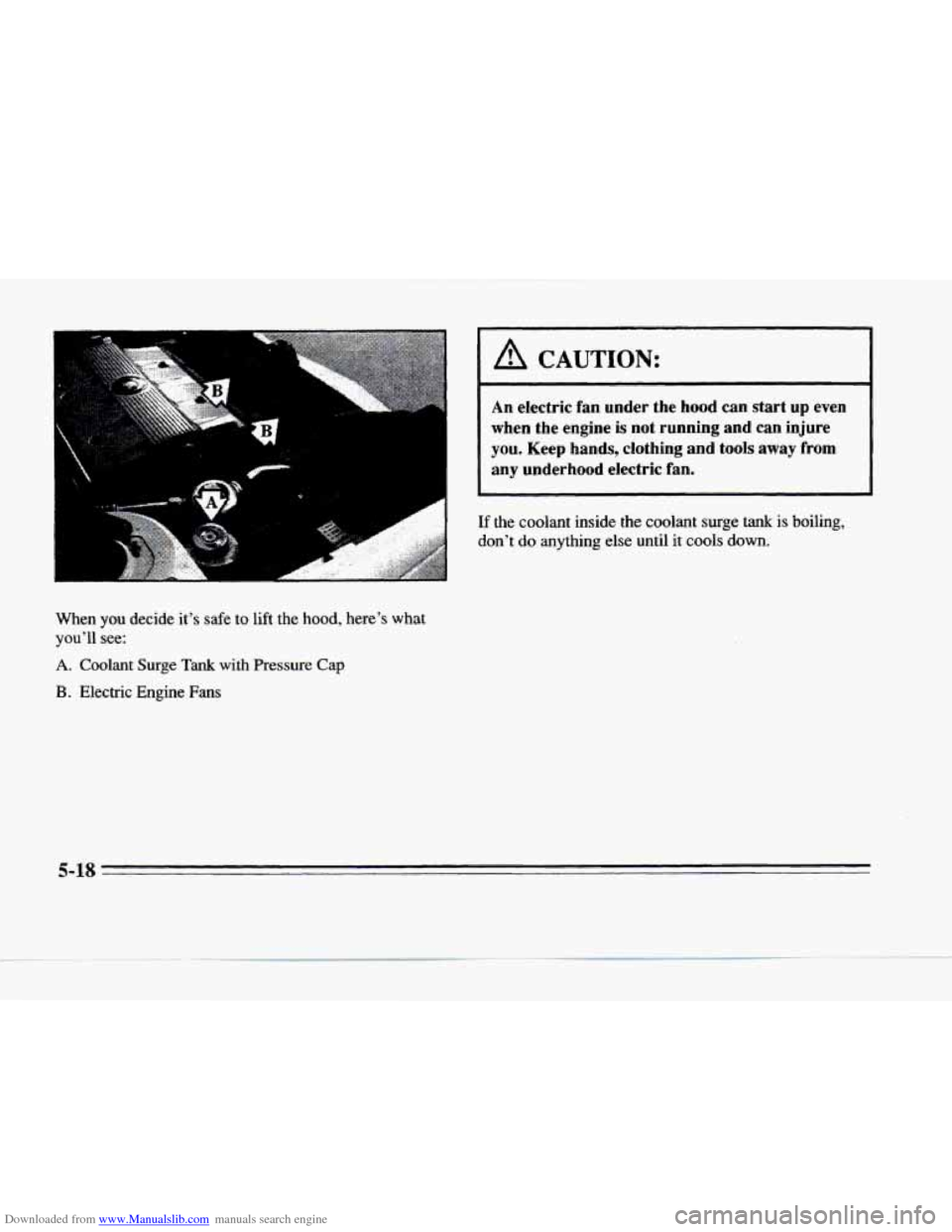
Downloaded from www.Manualslib.com manuals search engine "' sr""""
When you decide it's safe 'to lift the hood, here's what
you'll see:
A. Coolant Surge Tank with Pressure Cap
B. Electric Engine Fans
A CAUTION:
An electric fan under the hood can start up even
when the engine is not running and can injure
you. Keep hands, clothing and tools away from
any underhood electric fan.
If the coolant inside the coolant surge tank is boiling,
don't do anything else until
it cools down.
5-18
Page 242 of 354
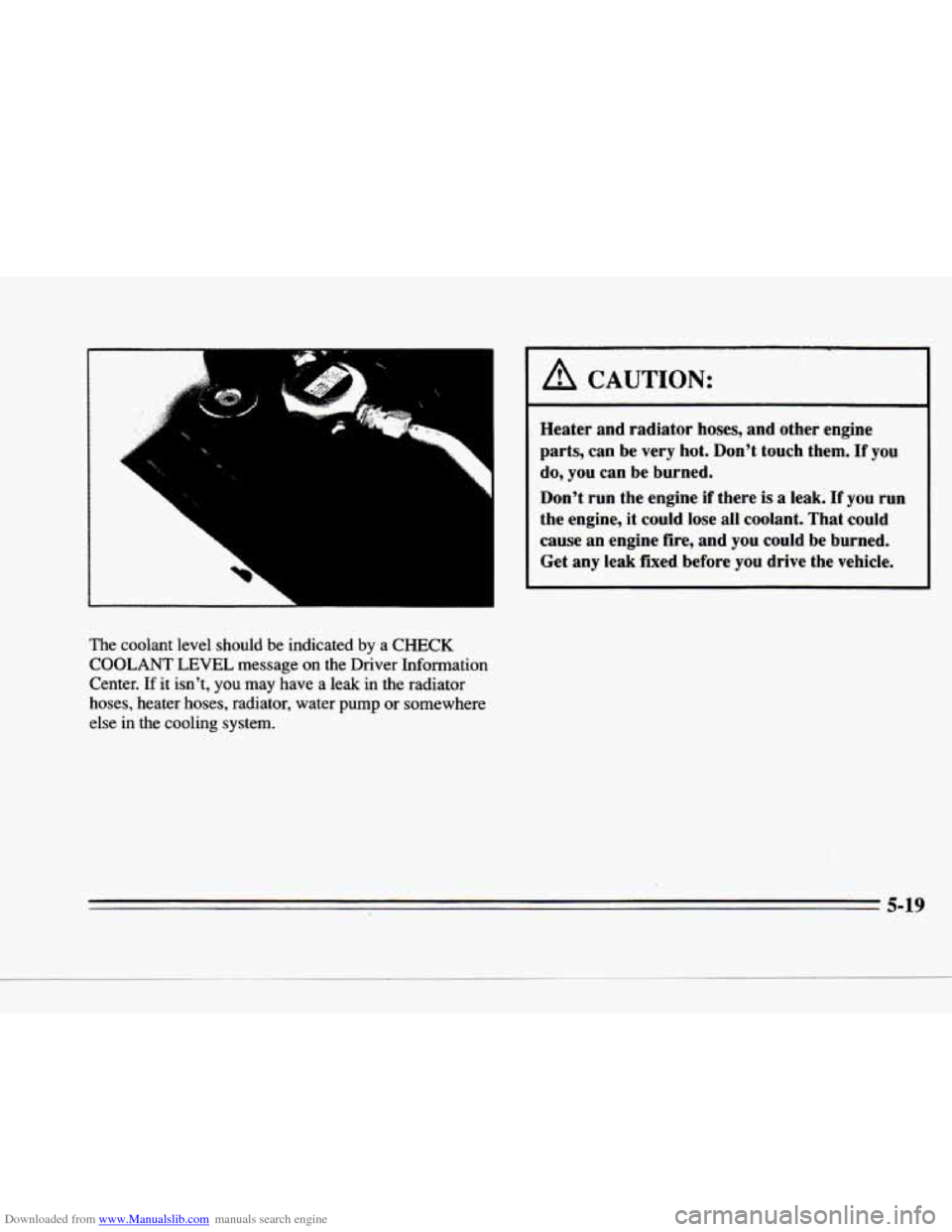
Downloaded from www.Manualslib.com manuals search engine F
c
7
a
The coolant level should be indicated by a CHECK
COOLANT LEVEL message on the Driver Information
Center.
If it isn't, you may have a leak in the radiator
hoses, heater
hoses, radiator, water pump or somewhere
else in the cooling system.
A CAUTION:
Heater and radiator hoses, and other engine
parts, can be very hot. Don't touch them.
If you
do, you can be burned.
Don't run the engine if there
is a leak. If you run
the engine,
it could lose all coolant. That could
cause an engine fire, and
you could be burned.
Get
any leak fixed before you drive the vehicle.
5-19
Page 243 of 354
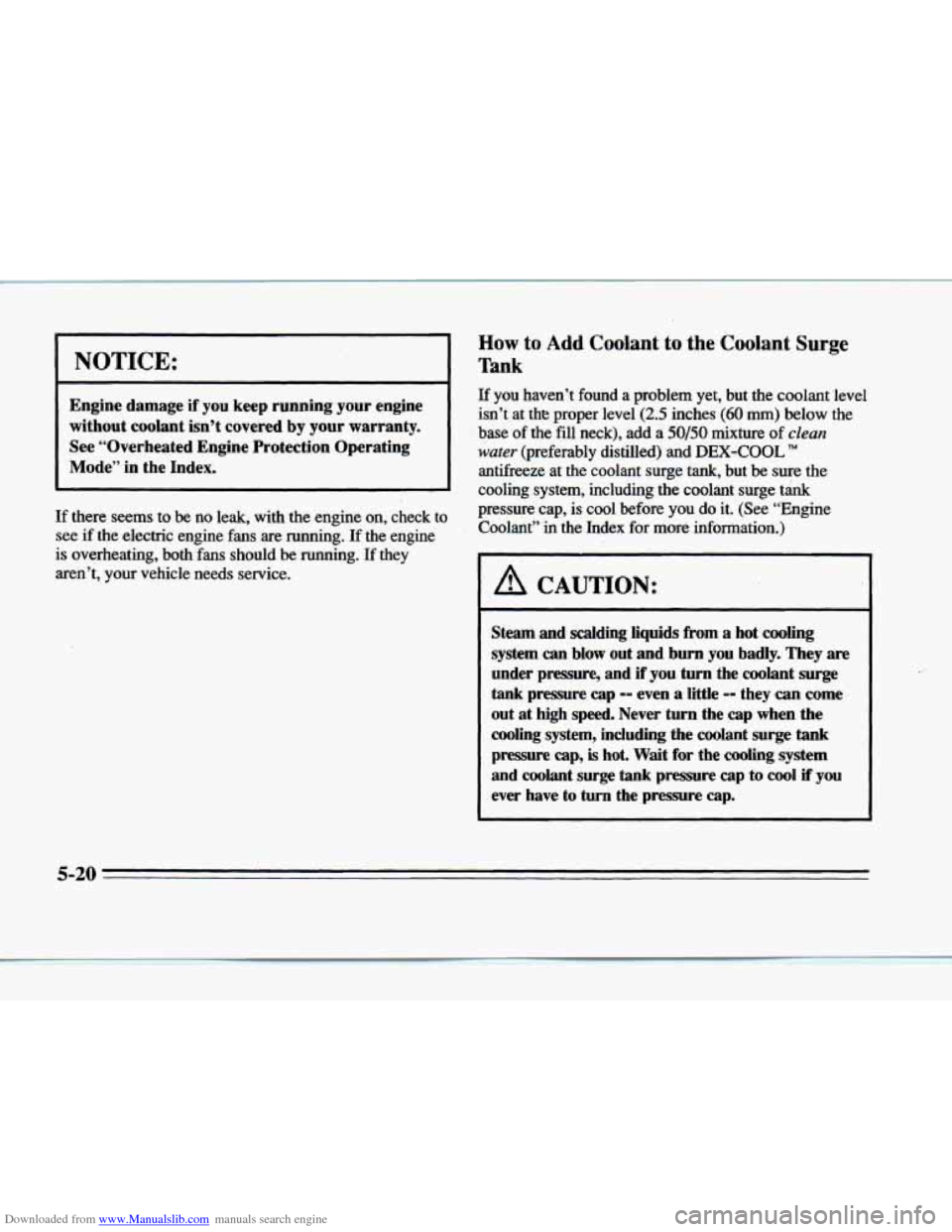
Downloaded from www.Manualslib.com manuals search engine I NOTICE:
Engine damage if you keep running your engine
without coolant isn’t covered
by your warranty.
See “Overheated Engine Protection Operating
Mode” in the Index.
If there seems to
be no leak, with the engine on, check to
see if the electric engine fans are running. If the engine
is overheating, both fans should
be running. If they
aren’t, your vehicle needs service.
How to Add Coolant to the Coolant Surge
Tank
If you haven? found a problem yet, but the coolant level
isn’t at
the proper level (2.5 inches (60 mm) below the
base
of the fill neck), add a 50/50 mixture of clean
water (preferably distilled) and DEX-COOL TM
antifreeze at the coolant surge tank, but be sure the
cooling system, including
the coolant surge tank
pressure cap, is cool before you do it. (See “Engine Coolant”
in the Index for more information.)
I A CAUTION:
Steam and scalding liquids from a hot cooling
system
can blow out and burn you badly. They are
under pressure, and if you turn the coolant surge
tank pressure cap -- even a little -- they can come
out at
high speed. Never turn the cap when the
cooling system, including the coolant surge tank
pressure cap,
is hot. Wait for the cooling system
and coolantsurge tank pressure cap to cool if you
ever
have to turn the pressure cap.
5-20
Page 244 of 354
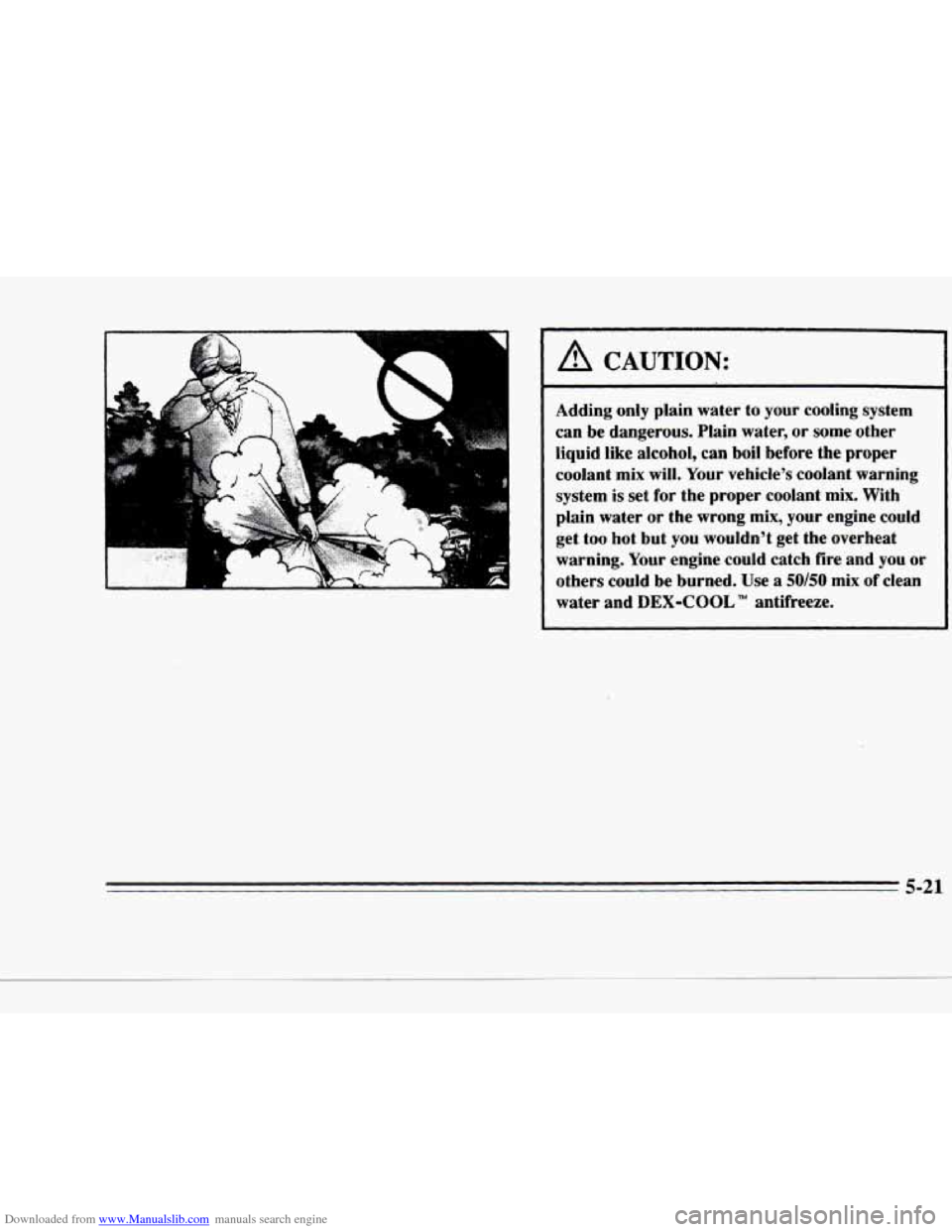
Downloaded from www.Manualslib.com manuals search engine c
A CAUTION:
Adding only plain water to your cooling system
can be dangerous. Plain water, or some other
liquid like alcohol,
can boil before the proper
coolant mix will. Your vehicle's coolant warning
system
is set for the proper coolant mix. With
plain water or the wrong mix, your engine could
get too hot but you wouldn't
get the overheat
warning. Your engine could catch fire and you
or
others could be burned. Use a 50/50 mix of clean
water and
DEX-COOL TM antifreeze.
5-21
c
Page 245 of 354
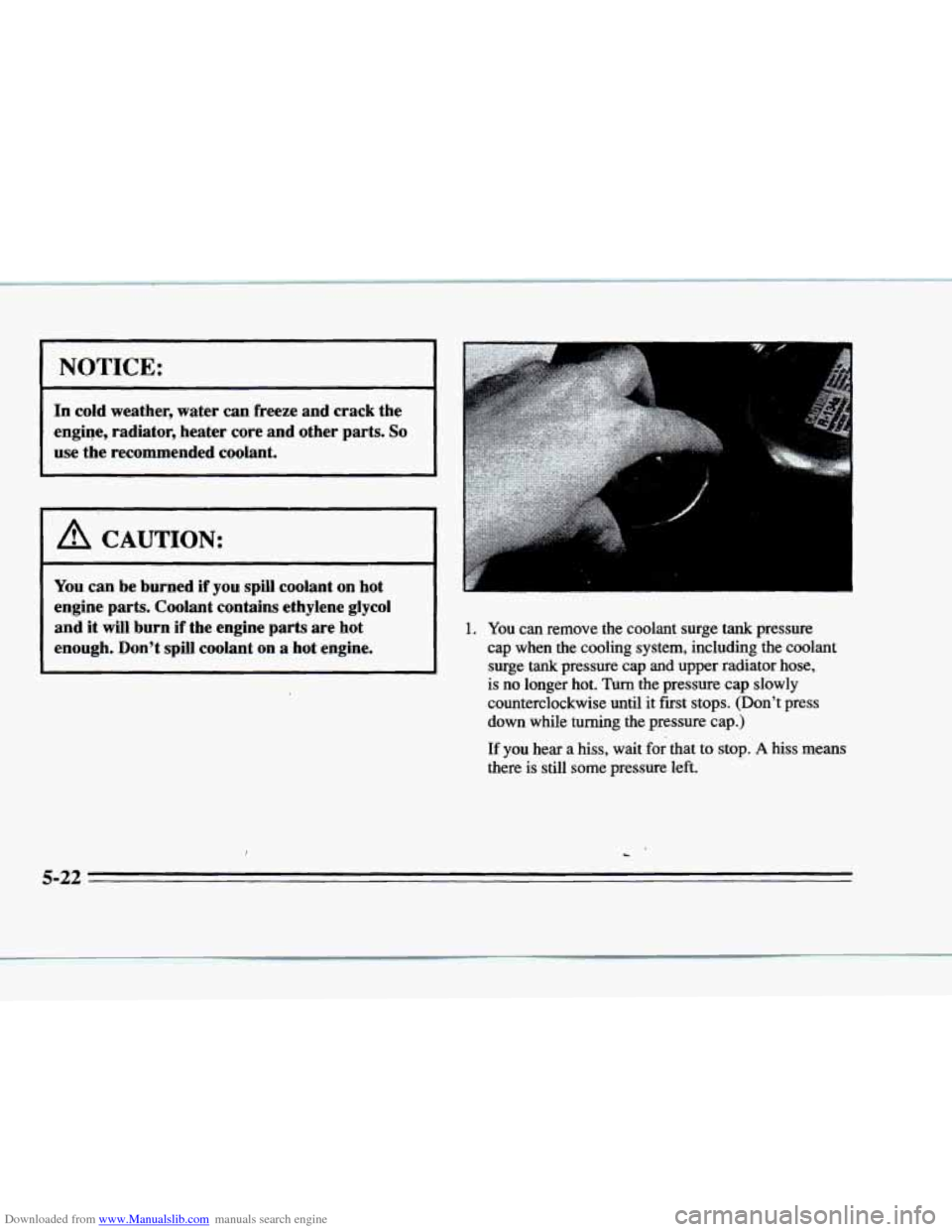
Downloaded from www.Manualslib.com manuals search engine NOTICE:
In cold weather, water can freeze and crack the
engine, radiator, heater core and other parts.
So
use the recommended coolant.
A CAUTION:
You can be burned if you spill coolant on hot
engine parts. Coolant contains ethylene glycol
and it
will burn if the engine parts are hot
enough. Don't spill coolant on
a hot engine.
A
1. You can remove the coolant surge tank pressure
cap when
the cooling system, including the coolant
surge tank pressure cap and upper radiator hose,
is no longer hot.
Turn the pressure cap slowly
counterclockwise until it first stops. (Don't press
down while turning the pressure cap.)
If you hear a hiss, wait for that to stop. A hiss means
there is
still some pressure left.
Page 246 of 354
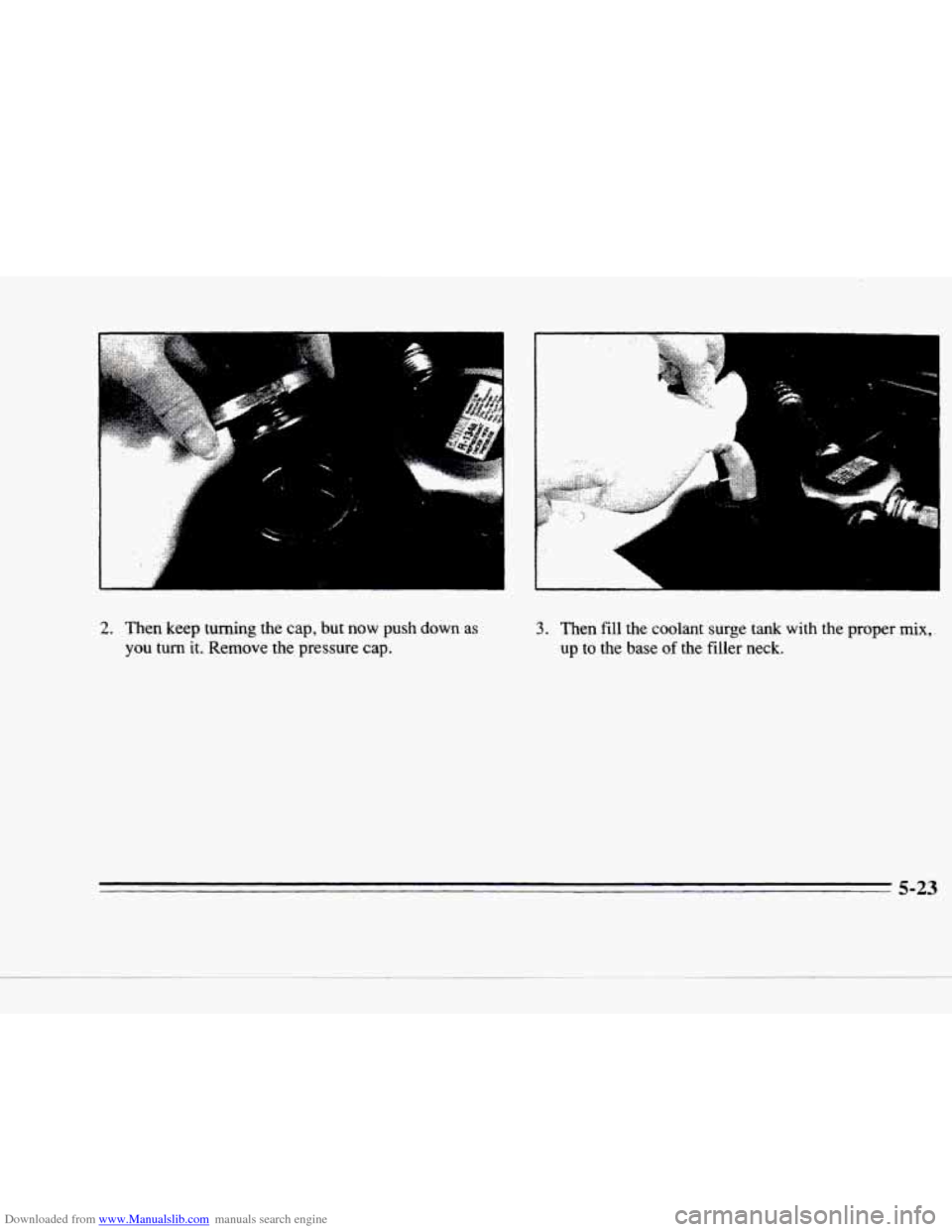
Downloaded from www.Manualslib.com manuals search engine 2. Then keep turning the cap, but now push down as
you turn it. Remove the pressure cap.
3. Then fill the coolant surge tank with the proper mix,
up
to the base of the filler neck.
5-23
Page 247 of 354
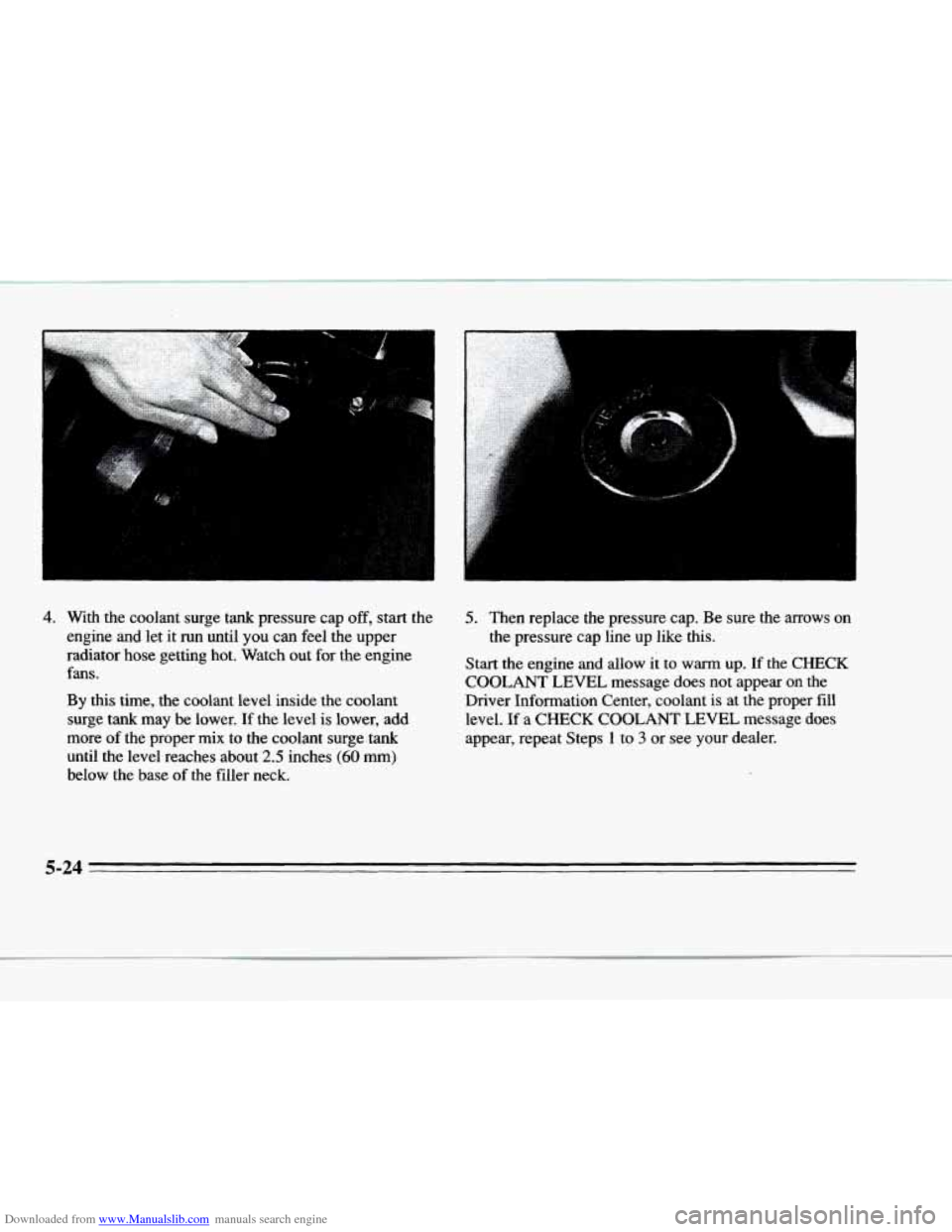
Downloaded from www.Manualslib.com manuals search engine k
4. With the coolant surge tank pressure cap off, start the
engine and let it run until
you can feel the upper
radiator hose getting hot. Watch out for the engine
fans.
By this time, the coolant level inside the coolant
surge tank may be lower.
If the level is lower, add
more
of the proper mix to the coolant surge tank
until the level reaches about
2.5 inches (60 mm)
below the base of the filler neck.
5. Then replace the pressure cap. Be sure the arrows on
the pressure cap line up like this.
Start
the engine and allow it to warm up. If the CHECK
COOLANT LEVEL message does not appear on the
Driver Information Center, coolant is at the proper fill
level.
If a CHECK COOLANT LEVEL message does
appear, repeat Steps 1 to
3 or see your dealer.
Page 248 of 354
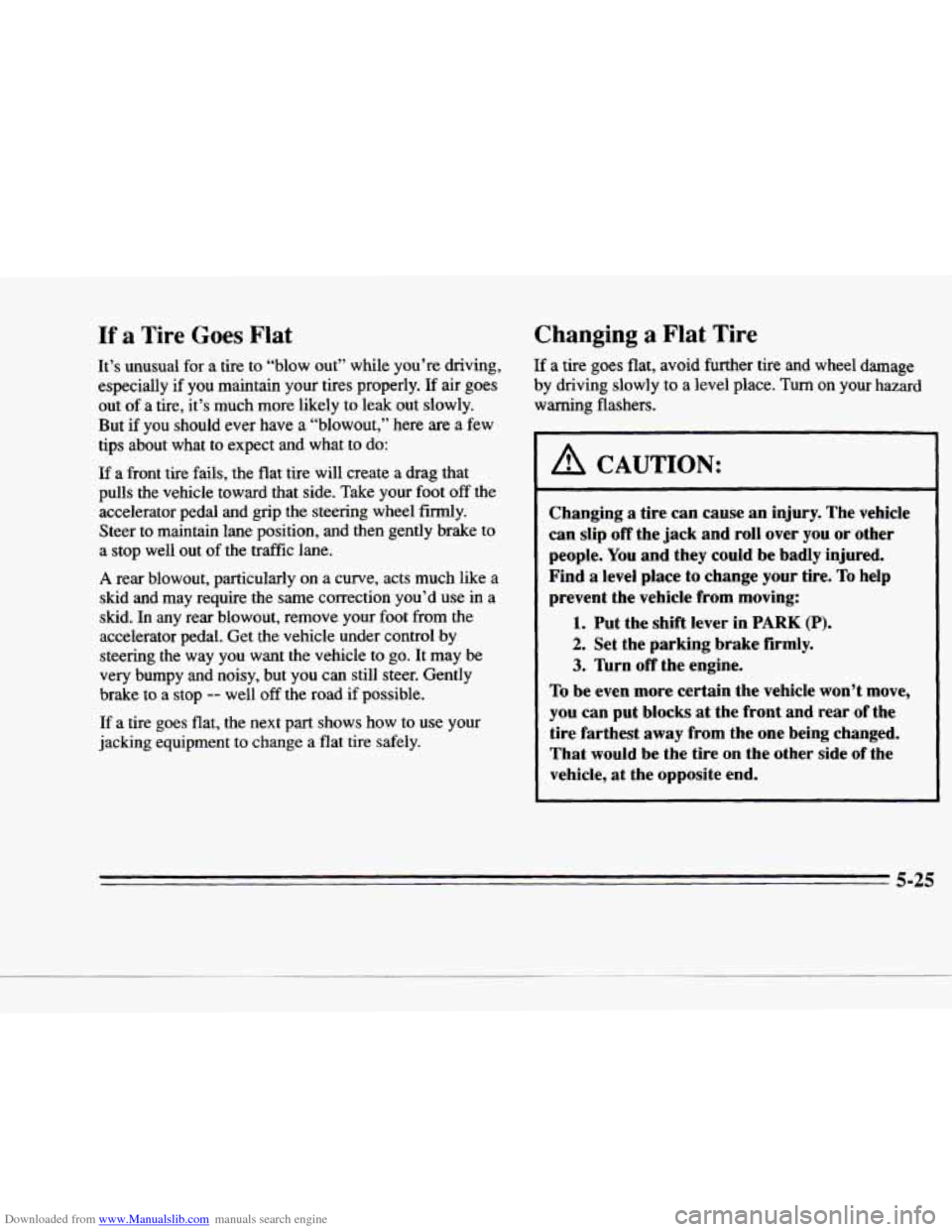
Downloaded from www.Manualslib.com manuals search engine c
LI
c
c
If a Tire Goes Flat
It’s unusual for a tire to “blow out” while you’re driving,
especially if you maintain
your tires properly. If air goes
out of
a tire, it’s much more likely to leak out slowly.
But if
you should ever have a “blowout,” here are a few
tips about what to expect and
what to do:
If a front tire fails, the flat tire will create a drag that
pulls the vehicle toward that side. Take your foot
off the
accelerator pedal and grip the steering wheel firmly.
Steer to maintain lane position, and then gently brake to
a stop well out
of the traffic lane.
A rear blowout, particularly on a curve, acts much like a
skid and
may require the same correction you’d use in a
skid. In any rear blowout, remove your foot from the
accelerator pedal. Get the vehicle under control
.by
steering the way you want the vehicle to go. It may be
very bumpy and noisy, but you can still steer. Gently
brake
to a stop -- well off the road if possible.
If a tire goes flat, the next
part shows how to use your
jacking equipment
to change a flat tire safely.
Changing a Flat Tire
If a tire goes flat, avoid further tire and wheel damage
by driving slowly to
a level place. Turn on your hazard
warning flashers.
A CAUTION:
~~
Changing a tire can cause an injury. The vehicle
can slip
off the jack and roll over you or.other
people. You and they could be badly injured.
Find
a level place to change your tire. To help
prevent the vehicle from moving:
1. Put the shift lever in PARK (P).
2. Set the parking brake firmly.
3. lhrn off the engine.
To be even more certain the vehicle won’t move,
you can put blocks
at the front and rear of the
tire farthest
away from the one being changed.
That
would be the tire on the other side of the
vehicle, at the opposite end.
5-25
Page 249 of 354
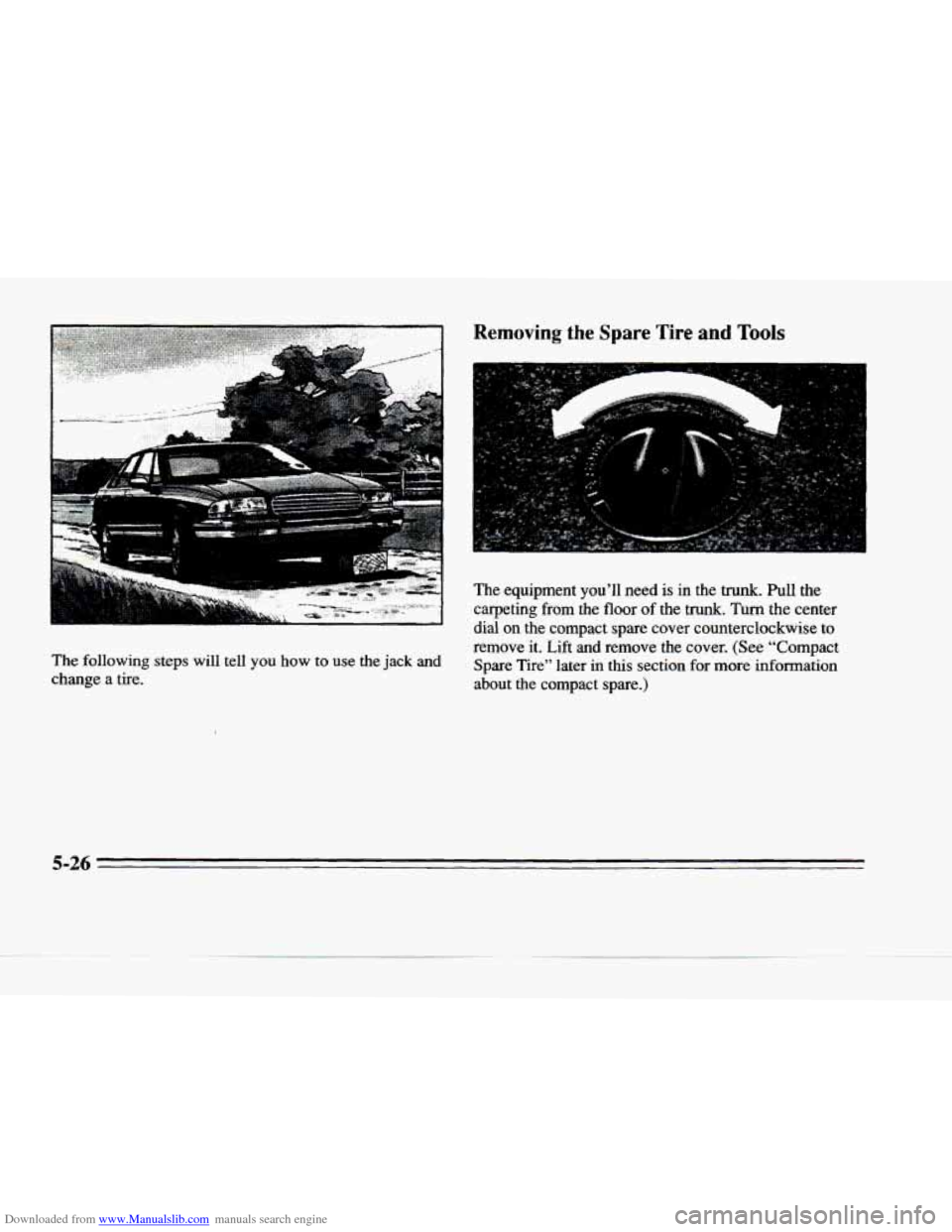
Downloaded from www.Manualslib.com manuals search engine I
The following steps will tell you how to use the jack and
change a tire.
Removing the Spare Tire and Tools
m
..
The equipment you’ll need is in the trunk. Pull the
carpeting from the floor
of the trunk. Turn the center
dial on the compact spare cover counterclockwise to
remove
it. Lift and remove the cover. (See “Compact
Spare Tire” later in this section
for more information
about the compact spare.)
5-26
Page 250 of 354
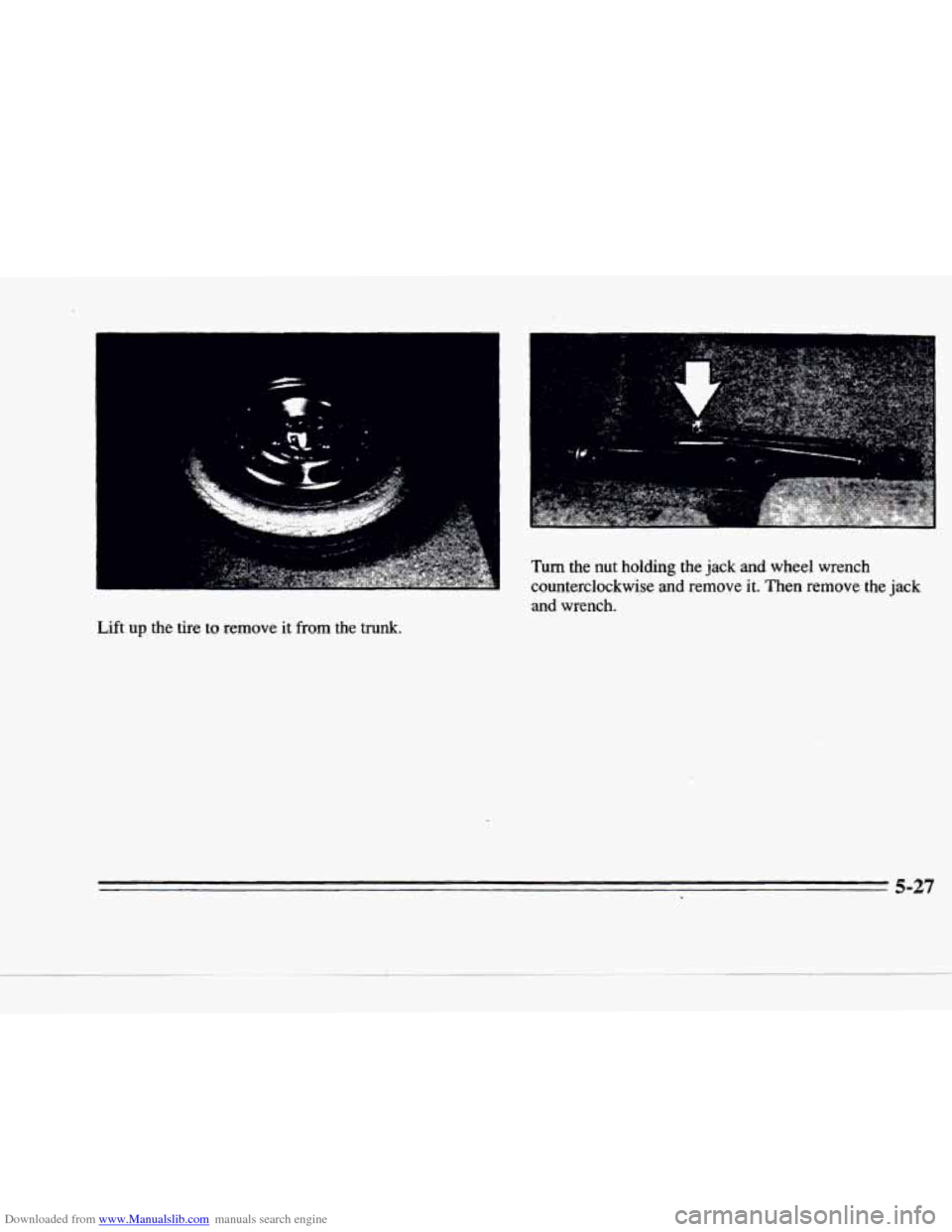
Downloaded from www.Manualslib.com manuals search engine c
**
Lift up the tire to remove it from the trunk. Turn
the nut
holding the jack and wheel wrench
counterclockwise
and remove it. Then remove the jack
and wrench.
5-27